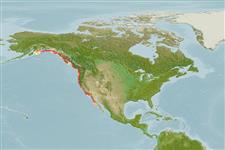>
Perciformes/Scorpaenoidei (Scorpionfishes) >
Sebastidae (Rockfishes, rockcods and thornyheads) > Sebastinae
Etymology: Sebastes: Greek, sebastes = august, venerable (Ref. 45335); caurinus: From the Latin caurinus, meaning 'northwest' (Ref. 27436).
More on author: Richardson.
Environment: milieu / climate zone / depth range / distribution range
Ecologia
marinhas demersal; intervalo de profundidade 10 - 183 m (Ref. 2850). Subtropical; 60°N - 27°N, 152°W - 114°W
Eastern Pacific: Kenai Peninsula, Gulf of Alaska to central Baja California, Mexico. The darker reddish phase from California may be a separate species (Ref. 27437).
Length at first maturity / Tamanho / Peso / Idade
Maturity: Lm 34.0, range 31 - 41 cm
Max length : 58.0 cm TL macho/indeterminado; (Ref. 27437); peso máx. Publicado: 2.7 kg (Ref. 40637); Idade máx. registada: 57 anos (Ref. 5483)
Descrição breve
Chaves de identificação | Morfologia | Morfometria
Espinhos dorsais (total) : 13; Raios dorsais moles (total) : 11 - 14; Espinhos anais: 3; Raios anais moles: 5 - 7; Vértebras: 25 - 26. Head spines strong - nasal, preocular, postocular, tympanic and parietal spines present, supraocular, coronal and nuchal spines absent (Ref. 27437). Caudal fin rounded (Ref. 6885). Olive brown to copper with pink or yellow blotches, white on sides and belly; rear two thirds of lateral line is white; usually with two dark bands radiating from eye; dorsal fin dark copper brown to black with some white (Ref. 27436). Branchiostegal rays: 7 (Ref. 36715).
Particularly abundant in shallow, protected bays and inlets, among rocks and kelp beds; also found around pilings and jetties or under floats (Ref. 27436). Juveniles found in loose aggregations in shallow weedy bays, around wharfs, or among floating drift associated with summer tidelines (Ref. 27436). Mainly a benthic feeder, may also take pelagic fishes (Ref. 27436). Viviparous, with planktonic larvae (Ref. 36715). Flesh is tasty, firm and flaky (Ref. 27436). Sold mainly as fresh fillets or live in Chinese restaurants and fish markets; excellent for fish chips or for pan frying as fillets (Ref. 27436).
Eschmeyer, W.N., E.S. Herald and H. Hammann, 1983. A field guide to Pacific coast fishes of North America. Boston (MA, USA): Houghton Mifflin Company. xii+336 p. (Ref. 2850)
Categoria na Lista Vermelha da IUCN (Ref. 130435)
Utilização humana
Pescarias: pouco comercial; peixe desportivo: sim; Aquário: Aquários públicos
Ferramentas
Relatórios especiais
Descarregue XML
Fontes da internet
Estimates based on models
Preferred temperature (Ref.
123201): 6.5 - 10, mean 8.3 °C (based on 53 cells).
Phylogenetic diversity index (Ref.
82804): PD
50 = 0.5000 [Uniqueness, from 0.5 = low to 2.0 = high].
Bayesian length-weight: a=0.01000 (0.00499 - 0.02004), b=3.09 (2.92 - 3.26), in cm total length, based on LWR estimates for this Genus-body shape (Ref.
93245).
Nível Trófico (Ref.
69278): 4.1 ±0.5 se; based on diet studies.
Resiliência (Ref.
120179): Baixo, tempo mínimo de duplicação da população 4,5 - 14 anos (K=0.12; tmax=55; tm=4; Fec=20,000).
Prior r = 0.18, 95% CL = 0.12 - 0.27, Based on 2 full stock assessments.
Fishing Vulnerability (Ref.
59153): Moderate to high vulnerability (49 of 100).
Nutrients (Ref.
124155): Calcium = 47.8 [14.1, 149.9] mg/100g; Iron = 0.676 [0.278, 1.809] mg/100g; Protein = 18.6 [17.5, 19.8] %; Omega3 = 0.696 [0.303, 1.610] g/100g; Selenium = 70.3 [25.8, 227.2] μg/100g; VitaminA = 21.3 [7.3, 64.1] μg/100g; Zinc = 0.456 [0.229, 0.865] mg/100g (wet weight);
